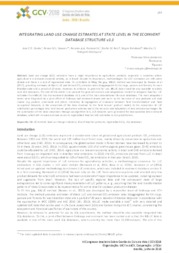Integrating land use change estimates at state level in the ecoinvent database structure v3.3.
Integrating land use change estimates at state level in the ecoinvent database structure v3.3.
Autoria: DONKE, A. C. G.; NOVAES, R. M. L.; PAZIANOTTO, R. A. A.; RUIZ, E. M.; REINHARD, J.; MATSUURA, M. I. da S. F.
Resumo: Abstract: Land use change (LUC) emissions have a major importance to agricultural products, especially in countries where agriculture is a relevant economic activity, as in Brazil. Despite its importance, methodologies for LUC estimation are still under debate and there is a lack of regionalized data. To contribute in filling this gap, BRLUC method was developed by Novaes et al (2017), providing estimates of direct LUC and derived CO2 emission rates disaggregated for 64 crops, pasture and forestry for each Brazilian state and a period of 20 years. However, to enhance its potential for use, BRLUC data should be also available in widely used LCA databases. The aim of this article is to present the general structure and adaptations needed to integrate Brazilian LUC estimates from BRLUC into the ecoinvent database v3.3, one of the main international life cycle databases. The main adaptation needs were diagnosed by a joint effort of Embrapa and ecoinvent teams and were: a) the inclusion of new products and land classes (e.g pasture, man-made and forest, intensive), b) segregation of emissions between ?land transformation? and ?land occupation? datasets; c) the conversion of the data structure to the ?land tenure? product model; d) the conversion of LUC substitution percentages into ?land tenure? production volumes and e) the inclusion and adaptation of new emission exchanges. By the automation of the data conversion through an algorithm in R, 418 datasets were generated for incorporation into ecoinvent database, which will increase and ease access to regionalized Brazilian LUC estimates to LCA practitioners.
Ano de publicação: 2018
Tipo de publicação: Artigo em anais e proceedings
Unidade: Embrapa Meio Ambiente
Observações
1 - Por padrão são exibidas publicações dos últimos 20 anos. Para encontrar publicações mais antigas, configure o filtro ano de publicação, colocando o ano a partir do qual você deseja encontrar publicações. O filtro está na coluna da esquerda na busca acima.
2 - Para ler algumas publicações da Embrapa (apenas as que estão em formato ePub), é necessário ter, no celular ou computador, um desses softwares gratuitos. Sistemas Android: Google Play Livros; IOS: iBooks; Windows e Linux: software Calibre.
Acesse outras publicações
Acesse a Base de Dados da Pesquisa Agropecuária (BDPA) para consultar o acervo completo das bibliotecas da Embrapa.

